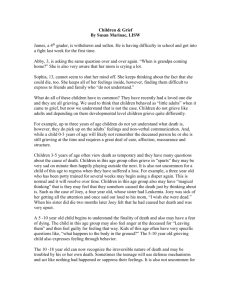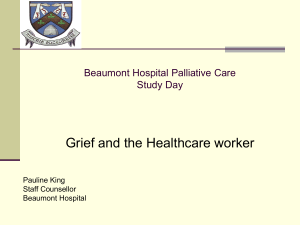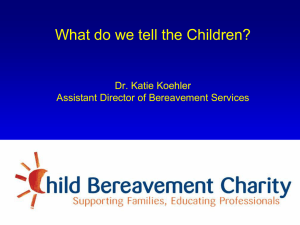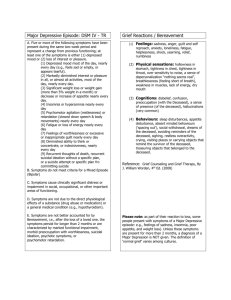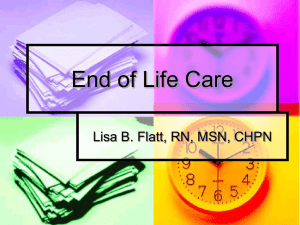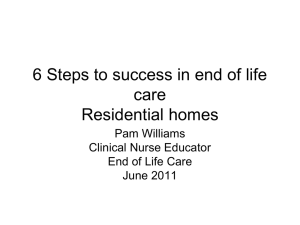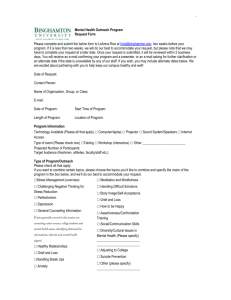DOROTHY HOUSE HOSPICE CARE BEREAVEMENT SERVICE
advertisement
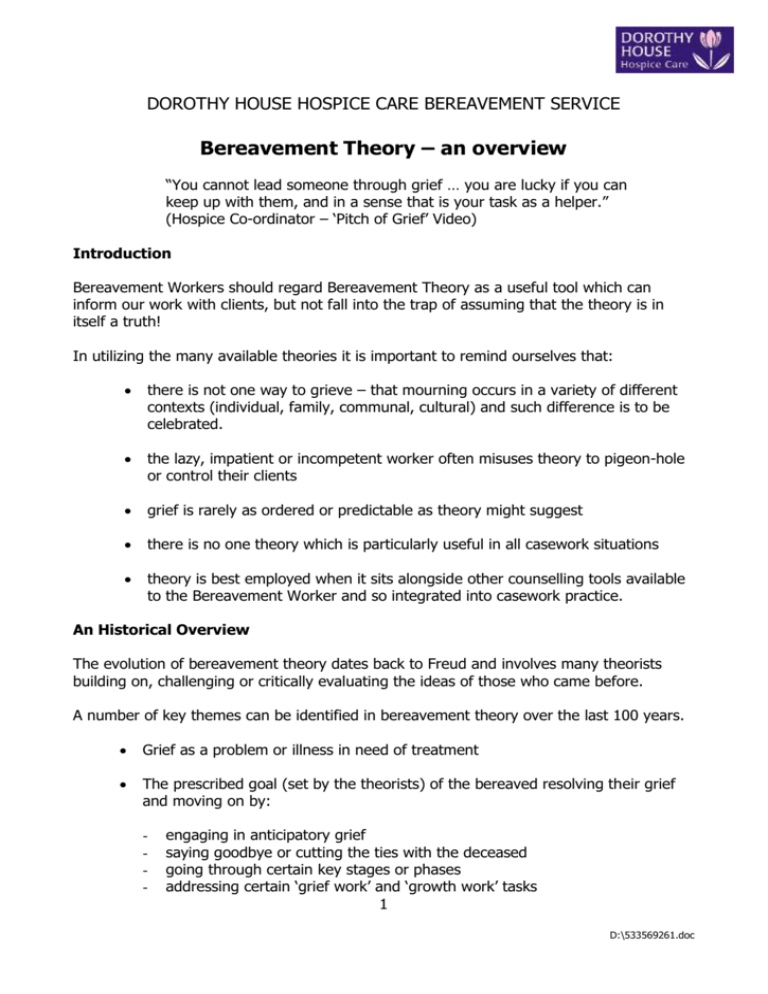
DOROTHY HOUSE HOSPICE CARE BEREAVEMENT SERVICE Bereavement Theory – an overview “You cannot lead someone through grief … you are lucky if you can keep up with them, and in a sense that is your task as a helper.” (Hospice Co-ordinator – ‘Pitch of Grief’ Video) Introduction Bereavement Workers should regard Bereavement Theory as a useful tool which can inform our work with clients, but not fall into the trap of assuming that the theory is in itself a truth! In utilizing the many available theories it is important to remind ourselves that: there is not one way to grieve – that mourning occurs in a variety of different contexts (individual, family, communal, cultural) and such difference is to be celebrated. the lazy, impatient or incompetent worker often misuses theory to pigeon-hole or control their clients grief is rarely as ordered or predictable as theory might suggest there is no one theory which is particularly useful in all casework situations theory is best employed when it sits alongside other counselling tools available to the Bereavement Worker and so integrated into casework practice. An Historical Overview The evolution of bereavement theory dates back to Freud and involves many theorists building on, challenging or critically evaluating the ideas of those who came before. A number of key themes can be identified in bereavement theory over the last 100 years. Grief as a problem or illness in need of treatment The prescribed goal (set by the theorists) of the bereaved resolving their grief and moving on by: - engaging in anticipatory grief saying goodbye or cutting the ties with the deceased going through certain key stages or phases addressing certain ‘grief work’ and ‘growth work’ tasks 1 D:\533569261.doc - relocating or internalizing the deceased through stories, ‘continuing bonds’, the search for meaning grieving together as a family, utilizing communal rituals Not being able to resolve grief and move on because of: - attachment problems - complicated or pathological grief - shattered dreams - disenfranchised grief Grief as having significant Individual, Cultural, Age and Gender Variables. 2 D:\533569261.doc MODELS & THEORIES THAT HAVE INFORMED BEREAVEMENT COUNSELLING AN HISTORICAL OVERVIEW! 2000 BOWMAN (Shattered Dreams) NEIMEYER (Meaning Reconstruction) 1990’s BUTLER & POWERS (Solution-focused Grief Therapy) MOOS (Family Systems) WHITE (Saying Hello) TONKIN (Growing Around Grief) STROEBE (Dual Orientation Model) WALTER (Bereavement & Biography) SILVERMAN (Continuing Bonds) 1980’s MACHIN (Reminiscence Work) *LE POIDEVIN (Grief & Growth Work) WORDEN (Tasks of Mourning) *LE POIDEVIN (Multi-dimensional Adjustment to Loss & Change) RANDO (Anticipatory Mourning) DOKA (Disenfranchised Grief) *DENVER GRIEF INSTITUTE (Phases of Grief) 1970’s PARKES & KUBLER-ROSS (Stage Model Theory) MASLOW (Hierarchy of Need) 1960’s BOWLBY ENGEL (Attachment, Separation (Trauma Healing) & Loss Theory) 1944 1917 LINDEMANN (Symptomatology of Acute Grief) FREUD (Mourning & Melancholia) * unpublished 3 D:\533569261.doc Freud - “Mourning and Melancholia” Mourning is a prolonged and inner struggle to accept that the loss is irreversible. Distress results from the struggle to both retain and relinquish the attachment to the deceased. Unresolved grief leads to depression. Relinquishing the attachments is a slow gradual process and involves withdrawing emotional energies and desires so that these can be invested in new relationships. Lindemann – “Symptomology of Acute Grief” The single most influential theorist on the symptomatology of grief. The first to suggest that the bereaved could be routinely assisted in resolving difficulties through ‘grief work’ with a professional. Acute grief is a definite syndrome with commonly occurring psychological & physical ‘symptoms’ including: Physical distress Preoccupation with the image of the deceased Preoccupation with the events leading up to the death Hostility Loss of established patterns of behaviour The appearance of traits associated with the deceased G. Engel – “Trauma Healing” The psychological trauma of a major bereavement is analogous to the physiological trauma of a severe injury – that ‘grief work’ is necessary for successful healing. Also believed that successful mourning could be tracked through a series of stages (so mirroring physical healing). Bowlby – “Attachment, Separation and Loss” Bereaved people have a strong drive to look for and find the lost person (‘searching’). Bowlby identified four phases that the bereaved go through numbness yearning & searching disorganisation and despair reorganisation of behaviour Those bereaved who grieve successfully are more likely to have had secure attachments with the deceased and in childhood. Those with a history of avoidant, anxious or ambivalent attachments will likely experience more complicated or pathological grief. Secure attachments provide for a greater sense of belonging & identity. Maslow – “Hierachy of Need” At times of crisis, loss or change humans have two different levels of need: basic needs include food, shelter, safety maturing needs include social association, affection, acceptance, self-esteem, the potential to grow and develop 4 D:\533569261.doc Parkes/Kubler-Ross – “Stage Model Theory” In adapting to loss and change most bereaved adults go through set stages: Denial Anger Bargaining Depression Acceptance Denver Grief Institute – “Phases of Grief” The grief process involves three distinct phases: Shock & protest Disorganisation Re-organisation Doka – “Disenfranchised Grief” Some losses are not or cannot be openly acknowledged, publicly mourned or socially supported, with the result that the bereaved can feel isolated and so a complicated grief reaction occurs. Examples of ‘disenfranchised grief’ might include: Bereaved through murder or suicide People with learning difficulties Secret or private relationships not based on recognisable kin-ties Stigmatised deaths (AIDS, drink-driving, alcohol/drug abuse, miscarriage, abortion) Minimised losses (death of a pet) The disenfranchised are often excluded from death rituals and information about support and entitlements. Rando – “Anticipatory Mourning” ‘Anticipatory grief’ occurs when there is an opportunity to anticipate the death of a loved one. Preparing for the loss offers the potential benefits of: Improving family communication Dealing with unfinished business Reinforcing the reality of the situation Saying goodbye Seeking and obtaining a wider range of support options Planning for the future Le Poidevin – “Multi-dimensional Adjustment to Loss and Change” Adjustment to loss relates to different time frames, is multi-dimensional and most critically is individual in nature. Le Poidevin suggested the following: The bereaved will strive to strike a healthy balance between ‘functioning work’, ‘grief work’ and ‘growth work’ with the balance of the three changing over time. The bereaved in adjusting to the loss will also strive to strike a healthy balance between ‘learning from the past’, ‘living in the present’ and ‘planning for the future’ 5 D:\533569261.doc That grief exploration takes place in 5 time periods adjustment to previous loss and change adjustment in preparation for the loss adjustment at the time of loss adjustment since the loss adjustment to future loss and change That in each time period there are 9 dimensions of adjustment to consider (intellectual, psychological, emotional, spiritual, physical, behavioural, social/cultural, sexual and practical) Worden – “Tasks of Mourning” Probably the most widely used and referred to bereavement model within the bereavement counselling profession. Worden proposed that for a bereaved adult to grieve healthily requires attention to four ‘tasks of mourning’: To accept the reality of the loss To experience the pain of grief To adjust to an environment in which the deceased is missing To integrate the deceased into a new future and to invest in new relationships and activities Silverman – “Continuing Bonds” Maintaining an ongoing attachment/connection with the deceased is an integral part of successful adaptation to loss. The ongoing attachment may be experienced through linking objects, symbolic conversations, meaningful rituals, reminiscence work etc. The ‘Continuing Bond’ recognises that the deceased is dead and won’t be returning, so isn’t avoidance or idealisation but rather a mechanism for internalising or relocating the deceased. White – “Saying Hello” Instead of ‘saying goodbye’ the bereaved’s task is the opposite – to ‘say hello’. By reclaiming their relationship with the lost loved one so the bereaved can help resolve the sense of emptiness they feel, can re-find themselves in a changed world and can reposition themselves in relation to the death of a loved one so generating new meanings. Moos – “Family Systems Theory” Families, through social interaction, develop enduring stories and beliefs which represent the group collectively and offer a degree of continuity and normality. The loss of a family member impacts on a number of inter-related levels including: Communication patterns Status and hierarchy Decision-making, power and control Collective belief systems and coping strategies Individual relationships ‘Systems models’ stress the influence of the family on how the death is perceived, whether grief can be openly expressed and shared, and the continuing involvement of the deceased in the family’s future functioning and development. 6 D:\533569261.doc Butler & Powers – “Solution-Focused Grief Therapy” The bereaved who choose to change have the resources so to do and setting achievable goals for themselves can be helpful. ‘Solution-focused’ ideas and techniques can serve to assist the change process and include: Future-oriented questions Exceptions (occasions when the problem is absent or less) Scaling questions Task setting Walter – “Bereavement & Biography” The bereaved’s goal is to construct a ‘story’ or narrative that places the deceased within their ongoing life – a ‘story’ capable of enduring through time, hence the dead person is lost and then re-found, rather than clung onto before being ultimately relinquished. Walter highlights examples from other societies and cultures where the notion ‘no-one is truly dead if we remember then’ is prevalent. By constructing this story the deceased has a number of ongoing roles: as a role model as a sage and mentor as a clarifier of the individual and family’s values/beliefs as a valued part of the bereaved biography Stroebe – “Dual Model of Orientation” The unhealthy extremes of persistent rumination or extreme avoidance, which could lead to a pathological grief reaction, are kept at bay if the bereaved adult ‘oscillates’ between two contrasting needs in grief: to be loss-oriented – so facing their grief and staying with the pain of the loss to be restoration-oriented – so focusing on the practicalities of the present and future (and by necessity suppressing thoughts and feelings associated with their loss) Machin – “Reminiscence Work” Remembering (or ‘reminiscence work’) can play an important part in the recovery from loss. Such work can utilise a variety of therapeutic vehicles – talking, listening, writing (diaries, poetry etc.), photographs, art, music, life-story projects, drama. By remembering connections are made, strengths reinforced, experiences are integrated and understood. Tonkin – “Growing around Grief” As the bereaved adjusts to their changed circumstances so there is the potential for ‘growing around grief’. Tonkin asserts that, rather than the pain of grief lessening over time and so becoming neat and manageable, in fact the pain remains potentially as powerful as in the acute phase (as experienced on significant anniversaries etc.), but that the bereaved person’s life can grow to accommodate the pain, without the pain of grief dominating day to day life as it did in the early days of bereavement. Bowman – “Shattered Dreams” An important challenge for many bereaved concerns ‘shattered dreams’ – the loss of an imagined future, or the need to re-evaluate certain assumptions about relationships, roles, beliefs, security in light of the recent death. 7 D:\533569261.doc Neimeyer – “Meaning Reconstruction” Healthy adjustment in bereavement is greatly helped when the bereaved has the ability to find meaning in experiences related to the loss (‘meaning reconstruction’). Such meanings can be sought and obtained in a number of contexts (individual, family, community) and often have a particular spiritual and/or cultural significance. References Bowlby, J 1980. A Secure Base: Parent-Child Attachment & Healthy Human Development. Basic Books Bowman, T 1997. Facing loss of dreams, a special kind of grief. International Journal of Palliative Nursing Vol. 3 No. 2 pp 76-79 Butler, W.R & Powers, K.V 1996. Solution-Focused Grief Therapy. In Miller, S et al (eds) Handbook of Solution-Focused Brief Therapy. San Francisco-Jossey Bass Publishers pp 228-247 Doka, K.J 1999. Disenfranchised Grief. Bereavement Care Vol. 18 No.3 Winter 1999 pp 37-39 Freud, S 1917. Mourning & Melancholia. Standard Edition Vol. 14 Klass, D, Silvermann, P.R, Nickman, S (eds) 1996. Continuing Bonds. New Understandings in Grief. Taylor & Francis. Kubler-Ross, E 2005. On Grief & Grieving. Schribner Kubler-Ross, E 1997. On Death & Dying. Touchstone Lindemann, E 1994. Symptomatology & Management of Acute Grief 1944. American Journal of Psychiatry June pp 151-160 Machin, L 1992. William Withington Memorial Lecture Maslow, A 1962. Toward a Psychology of Being. Wiley Moos, Riches, G & Dawson, P Systems Models of Grief. In an Intimate Loneliness pp 38-47 Neimeyer, R (ed) 2000. Meaning Reconstruction & the Experience of Loss. American Psychological Association Parkes, C. M 1972. Bereavement: Studies of Grief in Adult Life. Penguin Books Rando, T (ed) 2000. Clinical dimensions of anticipatory mourning. Champaign IL: Research Press Stroebe, M & Schut, H 1999. The Dual Process Model of Coping with Bereavement. Death Studies Vol 23 pp 197-224 Tonkin, L 1996. Growing Around Grief. Bereavement Care Vol. 15 No. 1 Spring 1996 pp10 Walter, T 1996. Bereavement & Biography Mortality Vol. 1 pp 7-25 White, M 1988. Saying Hullo Again: The incorporation of the lost relationship in the resolution of grief. Dulwich Centre. Spring Newsletter, Adelaide South Australia pp 7-11 Worden, W. J 1983. Grief Counselling, Grief Therapy. Brunner-Routledge Most of the authors referenced have written extensively on the subject of Bereavement theory. If you are especially interested in one particular theorist I would urge you to research their other writings in books, journals etc. Julian Bond Head of Family Support & Bereavement Services September 2005 8 D:\533569261.doc
